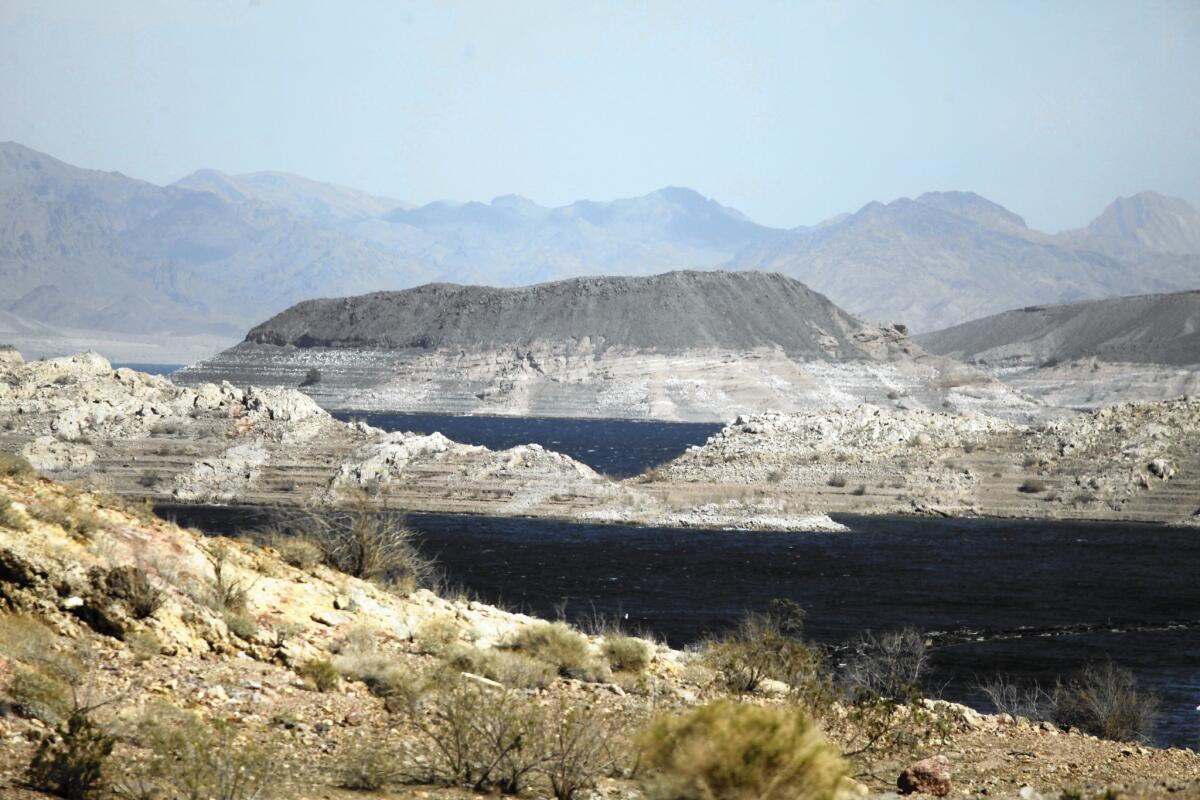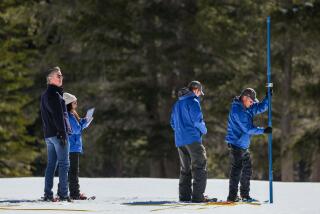Past thinking about California’s water may still bear pointers for future

- Share via
The decline of Lake Mead to a water level not seen in nearly eight decades, or since the giant reservoir was still filling behind the just-completed Hoover Dam, is more than a visual reminder of the severity of the drought.
It’s a reminder that this crucial part of California’s water supply, the economic lifeblood of the state, remains encumbered by false expectations and outdated dreams. It may also point to a way out of the crisis.
Then-Commerce Secretary Herbert Hoover and his technical advisor, Arthur Powell Davis, overestimated the flow of the Colorado River in 1922, during talks to apportion its waters among California and the six other states of the river basin, more to meet negotiators’ needs than to reflect credible hydrologic estimates. Their goal was to assure the states that the river could provide enough water to satisfy all their future needs, a guarantee that allowed the building of the dam that would eventually carry Hoover’s name. But in doing do, they advanced the mistaken idea that California and the West could rely on an inexhaustible bounty of water. Climate change and today’s punishing drought may finally have brought the era of optimism to a close.
“The old paradigm was that growth is good and we’ll just keep importing water,” reflects political scientist Steven P. Erie of UC San Diego, an expert on Southern California’s water history.
Today, that paradigm has become a burden to the state’s economic health as the pressure from headlong growth has run up against the implacable scarcity of water. But some of what drove the thinking about water use in the past still bears pointers for the future. It was based on long-term planning — a vision that extended 20, 30, even 50 years ahead. “That took hubris, but the time horizon for doing something about water is long,” says William Deverell, an expert on Western history at USC and the Huntington Library.
Similarly, the solutions depend on long-range thinking.
“We’re going to have to be bold,” says Vito Chiesa, who witnesses the water crisis from multiple vantage points as a member of the board of supervisors of Stanislaus County in the heart of the Central Valley agricultural belt; as an officer of the California State Assn. of Counties; and as a grower of almonds, walnuts, and peaches. In the farm region, he says, “we’ve lined canals, we have a much more efficient irrigation system, but what’s the next bold move?”
Chiesa senses that the realities of water supply and water economics may have started to bring Californians around to the realization that all water stakeholders — farmers, cities, the environment — are inextricably interconnected. Without that, no solution is conceivable.
“I want the fish to survive, I want the farmers to have reliable water, I want the cities to have clean water,” he says. “Those three forces have been fighting each other for 20 years. The environment’s dying, the farmers have less reliability than they ever have, and the cities have degrading water quality. What has the fighting and the stagnation gotten us? We have nothing to show for it.”
Consider the issue of water rights. Some Stanislaus County farmers hold the most senior rights in California, exempting them from the statewide water administration system established in 1914. But the assumption that they are immune to mandated cutbacks is ebbing.
“If you asked a year or two ago, they would have told you to bring out the National Guard if you were going to try to deal with their rights,” Chiesa says. “But everyone knows now there’s going to have to be shared pain of some sort.”
Yet land values supporting public and private investments — farm development, civic infrastructure, the growth of cities and towns — have been based upon the old expectations of access to water for a century or more. Mandates like fallowing farmland to provide more water for urban users can’t be imposed in a vacuum.
“The ag belt counties with the highest reliance on water happen to be the poorest in the state,” Chiesa says. “Do you make them really poor to keep the values up in Santa Clara County, L.A. and San Diego? Or do I pay a public goods tax to help pay for desalination on the coast” in return for keeping farmland in production? “That’s a bold thought, but that’s the kind of thing we’re going to need.”
Some of the solutions involve physical infrastructure. Just last week, Gov. Jerry Brown made another pitch for the $25-billion Bay Delta Conservation Plan, which encompasses two tunnels to convey water to Southern California and reconstruction of San Francisco-San Joaquin Delta levees. “Think of it as an insurance policy to continue the very sophisticated engineering that has characterized California,” he told a Sacramento business audience, harking back to the state’s can-do era of the 1950s and ‘60s, when it funded the State Water Project.
The tunnels themselves may not be the best solution to the water crisis, but billions of dollars in construction — whether new groundwater storage; environmentally sensitive conveyance, flood control and recycling systems; even desalination plants in the few locations where they can do the most good — plainly will be needed.
The widening bathtub ring around Lake Mead symbolizes the need for “a change in perception and in our culture,” as UCSD’s Erie puts it. “We’re still in denial.”
But no one can claim that the crisis was unforeseeable. At a water conference in 1893, Colorado River explorer John Wesley Powell — Arthur Powell Davis’ uncle — listened in dismay as speaker after speaker proclaimed a coming irrigation paradise in the West. “Gentlemen,” he finally shot back, “you are piling up a heritage of conflict and litigation over water rights, for there is not sufficient water to supply the land.” He was hooted out of the hall.
But whether he gets the last laugh depends on the resourcefulness and cooperation among the water users of today.
Michael Hiltzik’s column appears Sundays and Wednesdays. Read his blog, the Economy Hub, at latimes.com/business/hiltzik, reach him at [email protected], check out facebook.com/hiltzik and follow @hiltzikm on Twitter.
More to Read
Inside the business of entertainment
The Wide Shot brings you news, analysis and insights on everything from streaming wars to production — and what it all means for the future.
You may occasionally receive promotional content from the Los Angeles Times.











